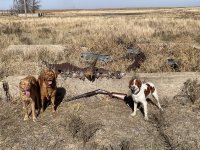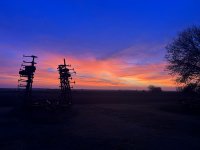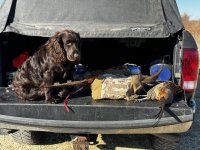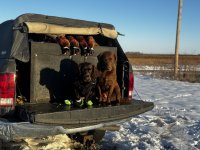I just got back from Kansas Trip, where i started the trip in Colby then hunted Osborne, Saw birds in Colby, skittish but had shots on a couple roosters and bagged some Quail, Osborne is around the same, Quail is good, but honestly, this is the worst year I have hunted in 5+ years of doing my trips. I worked dogs hard (3 of them), and just didn't have much luck at my usual places, most are mowed down, habitat lost, and just sad to see. Think I am going to give Kansas about 1/4 of the time next year, maybe good for a day in Colby and a day in Osborne, but that it. 70-degree days and either 15-30MPH wind or no wind surely didn't help. Very different from SD where I limited out by noon ditch hunting. Farmer said Osborne and Colby had 100+ degrees days this summer with limited water and high winds, which killed anything and everything cover-wise.
You are using an out of date browser. It may not display this or other websites correctly.
You should upgrade or use an alternative browser.
You should upgrade or use an alternative browser.
Opening Day in Kansas
- Thread starter OneEyedHunter
- Start date
I consider myself a big bowhunter and really wouldn’t mind seeing the whitetail population fizzle out at this point either if it meant upland birds would flourish. But I don’t feel like it’s an either/or necessarily. I’m interested in why you think there’s so much more money in upland visitors as opposed to deer hunters? South Dakota had around 75,000 non residents last year. That’s probably pretty close to the all time high for Kansas in the early 80’s. So it’s fair to assume that’s probably the ceiling these days if things magically did turn around. At those numbers we’re still only talking half the dollars in upland based license sales to the department that non resident deer hunting brings in. And I’m afraid there’s probably a misconception that upland guys automatically spend more money while they’re in state than deer hunters solely because they’re usually in larger groups I guess. It’s basically a 1:1 ratio of both hunter groups right now no matter how many orange vests you see together stomping out WIHAs. In my experience upland guys don’t stay as long as deer hunters, they’re more likely to carpool and share rooms, they certainly don’t pay as much for leased ground, there’s no bait/gear money being spent (as much as I hate to add that), and they don’t process their game at local lockers, etc. Even if non resident bird hunters got to that 2.5:1 ratio over deer guys I still don’t see the money coming even close to what the deer circus has become. Trust me, I’m with you in hoping that things swing back towards the birds, but I’m not that optimistic the money is there to drive it like you say.
I dont have the time at the moment to find some of the economic studies -- If I recall correctly there are some out there -- but when I mean look at upland hunting globally -take a 100k ft view instead of close up.
You're drilling in on non resident sales.
I dont care about that and anyone in the state should not either.
Here's a couple unarguable facts:
- Upland hunting (good upland hunting of good huntable #'s) is in short supply -- lets say 40s probably through 60s if I had to guess - about anywhere in the Continental US you could hunt upland birds -- it has slowly diminished to the point there are very few places with sustainable wild populations to provide decent hunting
- You can hunt White tail deer in any of the 50 states -- who gives a darn -- you have the german shepard sized deer in the south to the hoss's up north. They are not in short supply yet because of these animals and the corruption around them KS now allows people 4-5 mos to shoot one of these animals. Christ -- it's ludicrous. This allows some small groups to lock up large swaths of land so they can shoot their buck and limits access for NR's and R's alike.
- Let's get back to the supply issue and access issue-- because KS has focused mostly on deer for the past 30 years many properties have become tied up and access thus dwindled. This has led to MANY resident deer hunters and upland hunters alike to simply hang it up -- My dad did it -- I get it - many of my friends from college/Hs did -- my oldest son is 9 - Theres hardly any birds within a reasonable driving distance for a kid that young to cut his teeth on so I haven't been the best about introducing him quite yet -- I will but I get disallusioned with the lack of target opps much less access issues.
So my point is - and what I think many miss is that when upland hunting was good - it is a more social event than deer hunting -- there were small town hunters breakfasts, dinners, events night before season, cafes would be full most of season, motels full, restaurants full gas stations, sporting goods stores, walmart you name it - from RESIDENS and non residents alike -- License sales be damned -- you can go many times for upland birds and when you go you're going to spend money -- you can run many more upland hunting "Days" so to call it through the same parcel of land than you can deer hunters as there are simply only so many deer you can take off a property and they need much more room. A good upland property could be a quarter section of ground and could hold hundreds of pheasants and many covies of quail if it's set up right with the surrounding properties having the right recipes as well.
Lets get back to generational groups going -- it serves to introduce younger folks to hunting -- it's how I cut my teeth.
Anyways I could go on this topic for a long time -- hopefully I've somewhat supported where I was going with my statement -- there's so many moving parts I struggle to clearly communicate my logic.
It really would take a wholesale approach to change our trajectory -- we either need farming to collapse so all of a sudden it's now worth it for guys economically to plant habitat and sell upland hunts/access (I ran into a farmer in ND ironically that told me he made more money leasing to some guys and putting in habitat than cash renting the farmground or CRP)
Or we need a massive overhaul of how land is managed in the farm bill and someone needs to kick everyone of the corrupt big ag companies CEOs asses and end their corrupt control of ag policies and brainwashing of ag producers. I doubt that will happen so some sort of rule will need to be likely implemented to get them to stop selling poison and something else that is more environmentally friendly and enforce policies that make it more economically favorable to farm with more environmentally friendly practices.
I like to think positive - struggle with it at times - but the realist in me does not believe anything wildlife wise will change until there's some sort of calamity such as the dust bowl and those on the coasts or big cities are affected such as Black Sunday I believe -- then wholesale change may quickly happen. Until then it will be business as usual and every last iota of resource will be pillaged until it's all destroyed -- In KS case we will suck the Ogallallah aquifer dry and the western half of KS will become a desert -- So I guess when that happens we may get scalies or gambles moviing in if they can handle the cold -- but dont think I'll be alive to witness that.
There's your short answer --- Upland bird hunting -- more people, more hunting days will result in a much larger economic impact -- dont count out the residents -- I live in the e part of the state and it's nothing to drive 4-5 hours to get into semi decent hunting and away from the tick, honey suckle and invasive cool season grass infested forest I live in.
I can remember when you had to get your motel rooms booked, for next season, the same day you checked out!I dont have the time at the moment to find some of the economic studies -- If I recall correctly there are some out there -- but when I mean look at upland hunting globally -take a 100k ft view instead of close up.
You're drilling in on non resident sales.
I dont care about that and anyone in the state should not either.
Here's a couple unarguable facts:
- Upland hunting (good upland hunting of good huntable #'s) is in short supply -- lets say 40s probably through 60s if I had to guess - about anywhere in the Continental US you could hunt upland birds -- it has slowly diminished to the point there are very few places with sustainable wild populations to provide decent hunting
- You can hunt White tail deer in any of the 50 states -- who gives a darn -- you have the german shepard sized deer in the south to the hoss's up north. They are not in short supply yet because of these animals and the corruption around them KS now allows people 4-5 mos to shoot one of these animals. Christ -- it's ludicrous. This allows some small groups to lock up large swaths of land so they can shoot their buck and limits access for NR's and R's alike.
- Let's get back to the supply issue and access issue-- because KS has focused mostly on deer for the past 30 years many properties have become tied up and access thus dwindled. This has led to MANY resident deer hunters and upland hunters alike to simply hang it up -- My dad did it -- I get it - many of my friends from college/Hs did -- my oldest son is 9 - Theres hardly any birds within a reasonable driving distance for a kid that young to cut his teeth on so I haven't been the best about introducing him quite yet -- I will but I get disallusioned with the lack of target opps much less access issues.
So my point is - and what I think many miss is that when upland hunting was good - it is a more social event than deer hunting -- there were small town hunters breakfasts, dinners, events night before season, cafes would be full most of season, motels full, restaurants full gas stations, sporting goods stores, walmart you name it - from RESIDENS and non residents alike -- License sales be damned -- you can go many times for upland birds and when you go you're going to spend money -- you can run many more upland hunting "Days" so to call it through the same parcel of land than you can deer hunters as there are simply only so many deer you can take off a property and they need much more room. A good upland property could be a quarter section of ground and could hold hundreds of pheasants and many covies of quail if it's set up right with the surrounding properties having the right recipes as well.
Lets get back to generational groups going -- it serves to introduce younger folks to hunting -- it's how I cut my teeth.
Anyways I could go on this topic for a long time -- hopefully I've somewhat supported where I was going with my statement -- there's so many moving parts I struggle to clearly communicate my logic.
It really would take a wholesale approach to change our trajectory -- we either need farming to collapse so all of a sudden it's now worth it for guys economically to plant habitat and sell upland hunts/access (I ran into a farmer in ND ironically that told me he made more money leasing to some guys and putting in habitat than cash renting the farmground or CRP)
Or we need a massive overhaul of how land is managed in the farm bill and someone needs to kick everyone of the corrupt big ag companies CEOs asses and end their corrupt control of ag policies and brainwashing of ag producers. I doubt that will happen so some sort of rule will need to be likely implemented to get them to stop selling poison and something else that is more environmentally friendly and enforce policies that make it more economically favorable to farm with more environmentally friendly practices.
I like to think positive - struggle with it at times - but the realist in me does not believe anything wildlife wise will change until there's some sort of calamity such as the dust bowl and those on the coasts or big cities are affected such as Black Sunday I believe -- then wholesale change may quickly happen. Until then it will be business as usual and every last iota of resource will be pillaged until it's all destroyed -- In KS case we will suck the Ogallallah aquifer dry and the western half of KS will become a desert -- So I guess when that happens we may get scalies or gambles moviing in if they can handle the cold -- but dont think I'll be alive to witness that.
There's your short answer --- Upland bird hunting -- more people, more hunting days will result in a much larger economic impact -- dont count out the residents -- I live in the e part of the state and it's nothing to drive 4-5 hours to get into semi decent hunting and away from the tick, honey suckle and invasive cool season grass infested forest I live in.
Every restaurant had big hunters breakfast, gave free thermos fill up, and, if you weren't there30 minutes early, you had to wait on a table.
I get the sentiments surrounding the “good ol days” nostalgia. My grandparent’s farm is a mile off Hwy 24 and I can remember seeing the stream of bumper to bumper headlights heading west for hours on Friday evening. Goes without saying we’d all love to get back to that.
I think it’s a little narrow minded to say no one should care about non residents though. Unfortunately the non res dollar is one of the biggest drivers for landowners and game departments pretty much everywhere west of the Mississippi. South Dakota has decided pheasant tourism is their bread and butter while Kansas obviously went towards deer. Nothing is going to change just because some resident bird hunters want pheasants back. Something needs to drive it. Dust bowls and farm collapses seem a little far fetched and probably not what we want to root for. It is possible we’re in the middle of watching the demise of the deer herd in NWK and NCK. I think a more likely scenario might be that some of the landowners that got used to the money deer tourism created the last two decades will/would look into habitat work and birds to supplement that if the deer disappear. But again, the non resident dollar would be the main driver in that situation.
The state still gives out 5 whitetail doe tags in units 1, 3 and 7. I gues if you want to take some initiative yourself a fellow and some buddies could go help expedite the kill off out there! There aren’t five deer on an entire section across much of that region these days. Though working with landowners to thin out nest predators/coyotes might be a more worthy cause. The furbearer biologist said at a commission meeting this year that coyotes and coons are both at their highest population levels in at least a few decades, maybe ever.
Any real change is going to have to happen at a local level I believe. Small town businesses and local landowners that care about their communities can make the quickest impact. I follow a number of PF/QF chapters along with other conservation organizations around the state and hardly ever see any posts about actual habitat work, predator initiatives, access projects, etc. Seems it’s almost entirely posts about money being spent on youth licenses, scholarships and youth hunts (many of which take place on plant and shoot operations). That stuff is all great and much needed, but where is the actual effort to help the wildlife? If it doesn’t come from those folks you’re probably right, it may take an economic collapse or natural disaster to shake things up.
I think it’s a little narrow minded to say no one should care about non residents though. Unfortunately the non res dollar is one of the biggest drivers for landowners and game departments pretty much everywhere west of the Mississippi. South Dakota has decided pheasant tourism is their bread and butter while Kansas obviously went towards deer. Nothing is going to change just because some resident bird hunters want pheasants back. Something needs to drive it. Dust bowls and farm collapses seem a little far fetched and probably not what we want to root for. It is possible we’re in the middle of watching the demise of the deer herd in NWK and NCK. I think a more likely scenario might be that some of the landowners that got used to the money deer tourism created the last two decades will/would look into habitat work and birds to supplement that if the deer disappear. But again, the non resident dollar would be the main driver in that situation.
The state still gives out 5 whitetail doe tags in units 1, 3 and 7. I gues if you want to take some initiative yourself a fellow and some buddies could go help expedite the kill off out there! There aren’t five deer on an entire section across much of that region these days. Though working with landowners to thin out nest predators/coyotes might be a more worthy cause. The furbearer biologist said at a commission meeting this year that coyotes and coons are both at their highest population levels in at least a few decades, maybe ever.
Any real change is going to have to happen at a local level I believe. Small town businesses and local landowners that care about their communities can make the quickest impact. I follow a number of PF/QF chapters along with other conservation organizations around the state and hardly ever see any posts about actual habitat work, predator initiatives, access projects, etc. Seems it’s almost entirely posts about money being spent on youth licenses, scholarships and youth hunts (many of which take place on plant and shoot operations). That stuff is all great and much needed, but where is the actual effort to help the wildlife? If it doesn’t come from those folks you’re probably right, it may take an economic collapse or natural disaster to shake things up.
quailhunter101
Member
I just got back from Kansas Trip, where i started the trip in Colby then hunted Osborne, Saw birds in Colby, skittish but had shots on a couple roosters and bagged some Quail, Osborne is around the same, Quail is good, but honestly, this is the worst year I have hunted in 5+ years of doing my trips. I worked dogs hard (3 of them), and just didn't have much luck at my usual places, most are mowed down, habitat lost, and just sad to see. Think I am going to give Kansas about 1/4 of the time next year, maybe good for a day in Colby and a day in Osborne, but that it. 70-degree days and either 15-30MPH wind or no wind surely didn't help. Very different from SD where I limited out by noon ditch hunting. Farmer said Osborne and Colby had 100+ degrees days this summer with limited water and high winds, which killed anything and everything cover-wise.
quailhunter101
Member
We just finished a 3 day hunt. Definitely dry and chewing on dust. Thankful to see the rain as we drove out this morning. There are 4 of us that hunt 3 days every year in the same area. I don’t have the perspective from 20 years ago, but since 2012 I have seen some ups and downs but we have generally always had similar success and just enjoy the time together. The 2016 year after the 2012 drought recovery was definitely a peak for us. We were finding 10-12 coveys a day that year. We hunt all private with landowners that are cattle farmers that use grain harvest mostly to support their cattle. The mixture of pasture and grain is key to the sustainability we seem to see. One farmer in particular takes pride in dry farming practices with summer fallow fields, less field application and good rotation. Consequently his property always seems to raise birds. None of these farmers enroll in CRP.
On average we saw 40-50 pheasants per day and saw 4-5 coveys per day. We don’t consistently shoot limits and don’t generally try to. We average 10-15 miles of walking per day.
All said though, these landowners say this is the worst drought they have seen for sure. All say that pheasants and quail are not near what they were 20-30 years ago. My short collection of data gives me a concern for habitat that everyone discusses on this site. Even more so is the exit of the generation of smaller farmers that have a great pride in what they do. I don’t see the younger generation coming up behind to take over the practice. I am concerned that big ag companies and/or wealthy organizations buying up hunting leases will be their only option when their time is up. Then the pressure for progress and monetary wealth will continue to diminish the ‘pockets’ of good habitat that sustain.
Can’t be all doom and gloom though. Perhaps eternity in all of its perfection will provide the pursuit, thrill of the flush, quiet moments and comradery we look for. The earth is temporary, but still need to steward it well.
On average we saw 40-50 pheasants per day and saw 4-5 coveys per day. We don’t consistently shoot limits and don’t generally try to. We average 10-15 miles of walking per day.
All said though, these landowners say this is the worst drought they have seen for sure. All say that pheasants and quail are not near what they were 20-30 years ago. My short collection of data gives me a concern for habitat that everyone discusses on this site. Even more so is the exit of the generation of smaller farmers that have a great pride in what they do. I don’t see the younger generation coming up behind to take over the practice. I am concerned that big ag companies and/or wealthy organizations buying up hunting leases will be their only option when their time is up. Then the pressure for progress and monetary wealth will continue to diminish the ‘pockets’ of good habitat that sustain.
Can’t be all doom and gloom though. Perhaps eternity in all of its perfection will provide the pursuit, thrill of the flush, quiet moments and comradery we look for. The earth is temporary, but still need to steward it well.
Attachments
No one said they dont care about non residents -- My point was that it could turn around and we could have a great supply of a limited resource (that is upland hunting) -- it would attract non residents and re-activate non residents alike.I get the sentiments surrounding the “good ol days” nostalgia. My grandparent’s farm is a mile off Hwy 24 and I can remember seeing the stream of bumper to bumper headlights heading west for hours on Friday evening. Goes without saying we’d all love to get back to that.
I think it’s a little narrow minded to say no one should care about non residents though. Unfortunately the non res dollar is one of the biggest drivers for landowners and game departments pretty much everywhere west of the Mississippi. South Dakota has decided pheasant tourism is their bread and butter while Kansas obviously went towards deer. Nothing is going to change just because some resident bird hunters want pheasants back. Something needs to drive it. Dust bowls and farm collapses seem a little far fetched and probably not what we want to root for. It is possible we’re in the middle of watching the demise of the deer herd in NWK and NCK. I think a more likely scenario might be that some of the landowners that got used to the money deer tourism created the last two decades will/would look into habitat work and birds to supplement that if the deer disappear. But again, the non resident dollar would be the main driver in that situation.
The state still gives out 5 whitetail doe tags in units 1, 3 and 7. I gues if you want to take some initiative yourself a fellow and some buddies could go help expedite the kill off out there! There aren’t five deer on an entire section across much of that region these days. Though working with landowners to thin out nest predators/coyotes might be a more worthy cause. The furbearer biologist said at a commission meeting this year that coyotes and coons are both at their highest population levels in at least a few decades, maybe ever.
Any real change is going to have to happen at a local level I believe. Small town businesses and local landowners that care about their communities can make the quickest impact. I follow a number of PF/QF chapters along with other conservation organizations around the state and hardly ever see any posts about actual habitat work, predator initiatives, access projects, etc. Seems it’s almost entirely posts about money being spent on youth licenses, scholarships and youth hunts (many of which take place on plant and shoot operations). That stuff is all great and much needed, but where is the actual effort to help the wildlife? If it doesn’t come from those folks you’re probably right, it may take an economic collapse or natural disaster to shake things up.
As you alluded SD has the model for this - KS could do the same.
PF doesnt do squat -- they are supported by big interests and if you're donating they will just squander your money. I'd love to believe in their mission but it's all a bunch of smoke and mirrors when you look into it.
For KS -- and other ag heavy states -- Ag policy, the farm bill and people's willing use or non use of big chemical's poisons determines just as much as mother nature if not more whether there will be large quantities of upland birds again.
Upland birds are not the only things suffering - pollinators, insect diversity, plant diversity, soil health, meadowlarks...the list is endless of what ag policy and farming practices that started to become more widespread in the 90s have caused.
One farmer in particular takes pride in dry farming practices with summer fallow fields, less field application and good rotation. Consequently his property always seems to raise birds. None of these farmers enroll in CRP.
I'd bet my paycheck he has better soil health, biologic diversity and the list goes on at his place -- hence the reason for more upland numbers -- upland birds are the canaries in the coal mine -- if they're doing well - many other species are going to do well too.
Even more so is the exit of the generation of smaller farmers that have a great pride in what they do. I don’t see the younger generation coming up behind to take over the practice. I am concerned that big ag companies and/or wealthy organizations buying up hunting leases will be their only option when their time is up. Then the pressure for progress and monetary wealth will continue to diminish the ‘pockets’ of good habitat that sustain.
Yes -- this is and will be an issue going forward -- I've witnessed it and there's portions of western KS that are going and have been going this way -- at some point it will be for naught when they drain the ogallallah aquifer. Unfortunately more "Bill Gates" types and non local corps will be buying farms/ag land especially when more of the mundane tasks can be done using AI and robotics to work the fields. The big money on the coasts will just use the locals as their slaves to work the land.
brandent11
New member
I’m not even bothering to buy a KS tag this year. Those poor birds on WIHA/public are SCREWED
Uplandhunter67
Well-known member
Okay now that we’ve had a few pages discussing what and what’s not right in our state let’s get back to the op
Did a quick walk after work. Walked two miles. Flushed 3 hens and then 20 yards from the truck a rooster busts free and drops to the shot.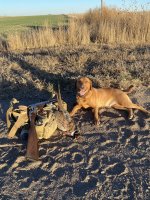 Then on Saturday I went old school for nostalgias sake. This is the 20ga Citori Superlight my father gave me in 1979. It was my primary shotgun until I parked it 1988 when I bought my Citori Upland Special.
Then on Saturday I went old school for nostalgias sake. This is the 20ga Citori Superlight my father gave me in 1979. It was my primary shotgun until I parked it 1988 when I bought my Citori Upland Special.
Figured I’d use it to chase chickens. On my way to the WIHA I stopped at a deep draw. It’s another piece of WIHA. Flushed a descent sized covey of quail. Two dropped at the flush and the rest sailed over onto private property.
On to my next stop I chased my favorite birds. Flushed a large covey of chickens well out of range. Found a straggler on the edge of the ridge. He fell to the 20ga.
Took a break for lunch and a nap at the house then headed out for an evening walk. I was walking the edge of thin yellow grass and wheat stubble when a rooster flushed in front of the dogs. Missed him on the first shot and rolled him on the second.
Overall a great day with some sweet nostalgia thrown in.

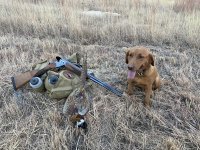
I have some family business out of state so I won’t be back in the field until mid December. Can’t wait to get back out.
Did a quick walk after work. Walked two miles. Flushed 3 hens and then 20 yards from the truck a rooster busts free and drops to the shot.
 Then on Saturday I went old school for nostalgias sake. This is the 20ga Citori Superlight my father gave me in 1979. It was my primary shotgun until I parked it 1988 when I bought my Citori Upland Special.
Then on Saturday I went old school for nostalgias sake. This is the 20ga Citori Superlight my father gave me in 1979. It was my primary shotgun until I parked it 1988 when I bought my Citori Upland Special.Figured I’d use it to chase chickens. On my way to the WIHA I stopped at a deep draw. It’s another piece of WIHA. Flushed a descent sized covey of quail. Two dropped at the flush and the rest sailed over onto private property.
On to my next stop I chased my favorite birds. Flushed a large covey of chickens well out of range. Found a straggler on the edge of the ridge. He fell to the 20ga.
Took a break for lunch and a nap at the house then headed out for an evening walk. I was walking the edge of thin yellow grass and wheat stubble when a rooster flushed in front of the dogs. Missed him on the first shot and rolled him on the second.
Overall a great day with some sweet nostalgia thrown in.


I have some family business out of state so I won’t be back in the field until mid December. Can’t wait to get back out.
BrownDogsCan2
Well-known member
westksbowhunter
Well-known member
GetTothePoint
Well-known member
I broke down and went out to what we'll say central area last weekend to hunt with some family in town. Cover was the best I'd actually seen in that area for a few years but it was terribly dry at that time. We saw birds in 1 wiha of countless we hunted Saturday and not even 1 quail. Everything we walked looked promising. Sunday we hunted private until the rain started and were on birds, pheasant and quail, all day, not loads but enough to keep it fun. This goes back to a lack of state ground per hunter as the walk ins are getting pounded multiple times a day, we saw more hunters than I expected and hoped too and if it weren't for the private we had it would have been a kansas hiking trip again I'm afraid.
BrownDogsCan2
Well-known member
OneEyedHunter
Member
I was very tempted to go, but the dogs needed a break after Sunday (19th), Wednesday, and Friday. Trace's vest has rubbed his armpits so raw that I was getting pressure at home to let him heal. Scout has a big barbed wire scratch/cut on her chest that also needs a couple of days. For the most part her vest will prevent it from getting worse, but the activity and constant rubbing from the vest slow the healing process. We get so few real snow days in Kansas that it was killing me to miss one, but there's still a lot of season left.
We're seeing birds and killing a few. Hunted private on Sunday, WIHA on Wednesday and Friday. It's about what I expected so far...
We're seeing birds and killing a few. Hunted private on Sunday, WIHA on Wednesday and Friday. It's about what I expected so far...
It's been so warm and dry, I've only been out once in KS. Hit my little lazy northeast honey hole. Put up some hens and a spectacular covey of bobs in a quick walk. This weekend with the snow...I opted for Iowa public instead of Kansas private. It used to be that if I was going to drive a few hours to chase roosters, I went west. I think my time is better spent now heading up I-29 or I-35 instead of down I-70. I'm very happy some of you are out there and finding a little success and some reasons to keep walking, though. I sure miss the feeling of heading out into Kansas every weekend this time of year.

